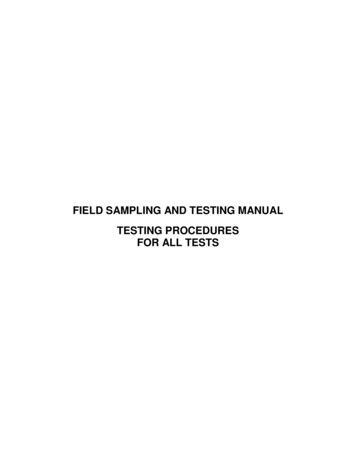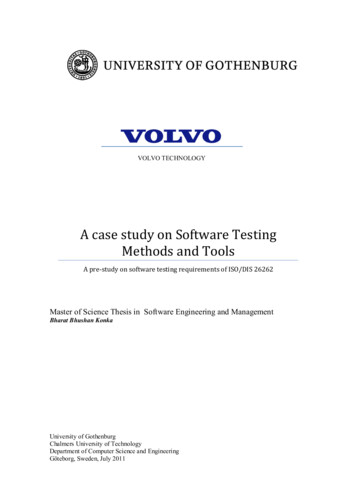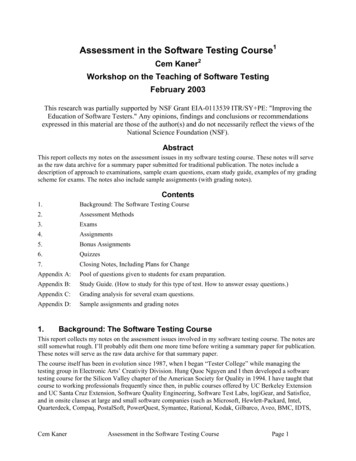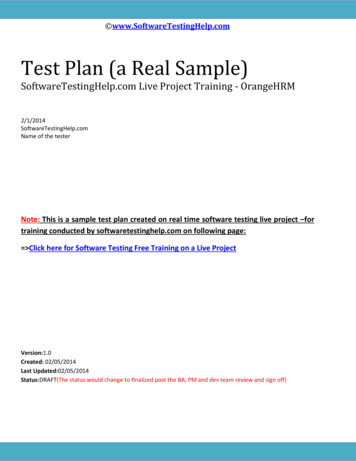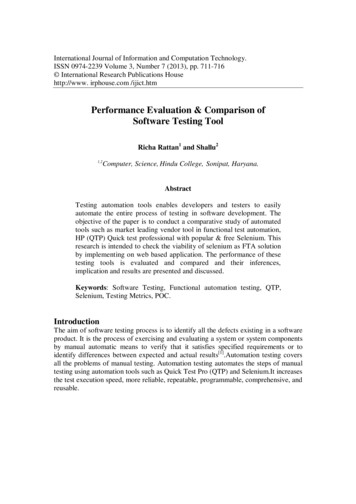
Transcription
Beginners Guide To Software TestingBeginners Guide To Software Testing- Padmini CPage 1
Beginners Guide To Software TestingTable of Contents:1. Overview . 5The Big Picture . 5What is software? Why should it be tested? . 6What is Quality? How important is it? . 6What exactly does a software tester do? . 7What makes a good tester? . 8Guidelines for new testers . 92. Introduction. 11Software Life Cycle . 11Various Life Cycle Models . 12Software Testing Life Cycle . 13What is a bug? Why do bugs occur? . 15Bug Life Cycle . 16Cost of fixing bugs . 17When can testing be stopped/reduced?. 183. Software Testing Levels, Types, Terms and Definitions . 19Testing Levels and Types . 19Page 2
Beginners Guide To Software TestingTesting Terms . 22Most common software errors . 23Types of errors with examples . 235. The Test Planning Process . 25What is a Test Strategy? What are its Components? . 25Test Planning – Sample Structure . 25Major Test Planning Tasks . 266. Test Case Development . 27General Guidelines . 27Test Case – Sample Structure . 27Test Case Design Techniques . 28What is a Use Case? . 307. Defect Tracking. 31What is a defect?. 31What are the defect categories? . 31How is a defect reported? . 32How descriptive should your bug/defect report be? . 32What does the tester do when the defect is fixed? . 338. Types of Test Reports . 349. Software Test Automation . 35Page 3
Beginners Guide To Software TestingApproaches to Automation . 36Choosing the right tool . 37Top Ten Challenges of Software Test Automation. 3710. Introduction to Software Standards. 38Six Sigma. 38ISO . 3911. Software Testing Certifications . 4012. Facts about Software Engineering . 41Page 4
Beginners Guide To Software Testing1. OverviewThe Big PictureAll software problems can be termed as bugs. A software bug usually occurs when thesoftware does not do what it is intended to do or does something that it is notintended to do. Flaws in specifications, design, code or other reasons can cause thesebugs. Identifying and fixing bugs in the early stages of the software is very importantas the cost of fixing bugs grows over time. So, the goal of a software tester is to findbugs and find them as early as possible and make sure they are fixed.Testing is context-based and risk-driven. It requires a methodical and disciplinedapproach to finding bugs. A good software tester needs to build credibility andpossess the attitude to be explorative, troubleshooting, relentless, creative,diplomatic and persuasive.As against the perception that testing starts only after the completion of codingphase, it actually begins even before the first line of code can be written. In the lifecycle of the conventional software product, testing begins at the stage when thespecifications are written, i.e. from testing the product specifications or product spec.Finding bugs at this stage can save huge amounts of time and money.Once the specifications are well understood, you are required to design and executethe test cases. Selecting the appropriate technique that reduces the number of teststhat cover a feature is one of the most important things that you need to take intoconsideration while designing these test cases. Test cases need to be designed tocover all aspects of the software, i.e. security, database, functionality (critical andgeneral) and the user interface. Bugs originate when the test cases are executed.As a tester you might have to perform testing under different circumstances, i.e. theapplication could be in the initial stages or undergoing rapid changes, you have lessthan enough time to test, the product might be developed using a life cycle modelthat does not support much of formal testing or retesting. Further, testing usingdifferent operating systems, browsers and the configurations are to be taken care of.Reporting a bug may be the most important and sometimes the most difficult taskthat you as a software tester will perform. By using various tools and clearlycommunicating to the developer, you can ensure that the bugs you find are fixed.Using automated tools to execute tests, run scripts and tracking bugs improvesefficiency and effectiveness of your tests. Also, keeping pace with the latestdevelopments in the field will augment your career as a software test engineer.Page 5
Beginners Guide To Software TestingWhat is software? Why should it be tested?Software is a series of instructions for the computer that perform a particular task,called a program; the two major categories of software are system software andapplication software. System software is made up of control programs. Applicationsoftware is any program that processes data for the user (spreadsheet, wordprocessor, payroll, etc.).A software product should only be released after it has gone through a properprocess of development, testing and bug fixing. Testing looks at areas such asperformance, stability and error handling by setting up test scenarios undercontrolled conditions and assessing the results. This is why exactly any software hasto be tested. It is important to note that software is mainly tested to see that it meetsthe customers’ needs and that it conforms to the standards. It is a usual norm thatsoftware is considered of good quality if it meets the user requirements.What is Quality? How important is it?Quality can briefly be defined as “a degree of excellence”. High quality softwareusually conforms to the user requirements. A customer’s idea of quality may cover abreadth of features - conformance to specifications, good performance onplatform(s)/configurations, completely meets operational requirements (even if notspecified!), compatibility to all the end-user equipment, no negative impact onexisting end-user base at introduction time.Quality software saves good amount of time and money. Because software will havefewer defects, this saves time during testing and maintenance phases. Greaterreliability contributes to an immeasurable increase in customer satisfaction as well aslower maintenance costs. Because maintenance represents a large portion of allsoftware costs, the overall cost of the project will most likely be lower than similarprojects.Following are two cases that demonstrate the importance of software quality:Ariane 5 crash June 4, 1996- Maiden flight of the European Ariane 5 launcher crashed about 40 seconds aftertakeoff- Loss was about half a billion dollars- Explosion was the result of a software error- Uncaught exception due to floating-point error: conversion from a 64-bitinteger to a 16-bit signed integer applied to a larger than expectedPage 6
Beginners Guide To Software Testingnumber- Module was re-used without proper testing from Ariane 4- Error was not supposed to happen with Ariane 4- No exception handlerMars Climate Orbiter - September 23, 1999- Mars Climate Orbiter, disappeared as it began to orbit Mars.- Cost about US 125-million- Failure due to error in a transfer of information between a team in Coloradoand a team in California- One team used English units (e.g., inches, feet and pounds) while the other usedmetric units for a key spacecraft operation.What exactly does a software tester do?Apart from exposing faults (“bugs”) in a software product confirming that theprogram meets the program specification, as a test engineer you need to create testcases, procedures, scripts and generate data. You execute test procedures andscripts, analyze standards and evaluate results of system/integration/regressiontesting. You also. Speed up development process by identifying bugs at an early stage (e.g.specifications stage) Reduce the organization's risk of legal liability Maximize the value of the software Assure successful launch of the product, save money, time and reputation ofthe company by discovering bugs and design flaws at an early stage beforefailures occur in production, or in the field Promote continual improvementPage 7
Beginners Guide To Software TestingWhat makes a good tester?As software engineering is now being considered as a technical engineeringprofession, it is important that the software test engineer’s posses certain traits witha relentless attitude to make them stand out. Here are a few. Know the technology. Knowledge of the technology in which the application isdeveloped is an added advantage to any tester. It helps design better and powerfultest cases basing on the weakness or flaws of the technology. Good testers knowwhat it supports and what it doesn’t, so concentrating on these lines will help thembreak the application quickly. Perfectionist and a realist. Being a perfectionist will help testers spot the problemand being a realist helps know at the end of the day which problems are reallyimportant problems. You will know which ones require a fix and which ones don’t. Tactful, diplomatic and persuasive. Good software testers are tactful and knowhow to break the news to the developers. They are diplomatic while convincing thedevelopers of the bugs and persuade them when necessary and have their bug(s)fixed. It is important to be critical of the issue and not let the person who developedthe application be taken aback of the findings. An explorer. A bit of creativity and an attitude to take risk helps the testersventure into unknown situations and find bugs that otherwise will be looked over. Troubleshoot. Troubleshooting and figuring out why something doesn’t workhelps testers be confident and clear in communicating the defects to the developers. Posses people skills and tenacity. Testers can face a lot of resistance fromprogrammers. Being socially smart and diplomatic doesn't mean being indecisive. Thebest testers are both-socially adept and tenacious where it matters. Organized. Best testers very well realize that they too can make mistakes anddon’t take chances. They are very well organized and have checklists, use files, factsand figures to support their findings that can be used as an evidence and doublecheck their findings. Objective and accurate. They are very objective and know what they report and soconvey impartial and meaningful information that keeps politics and emotions out ofmessage. Reporting inaccurate information is losing a little credibility. Good testersmake sure their findings are accurate and reproducible. Defects are valuable. Good testers learn from them. Each defect is an opportunityto learn and improve. A defect found early substantially costs less when compared tothe one found at a later stage. Defects can cause serious problems if not managedproperly. Learning from defects helps – prevention of future problems, trackimprovements, improve prediction and estimation.Page 8
Beginners Guide To Software TestingGuidelines for
Software Testing Certifications . 40 12. Facts about Software Engineering . 41 . Beginners Guide To Software Testing Page 5 1. Overview The Big Picture All software problems can be termed as bugs. A software bug usually occurs when the software does not do what it is intended to do or does something that it is not .



